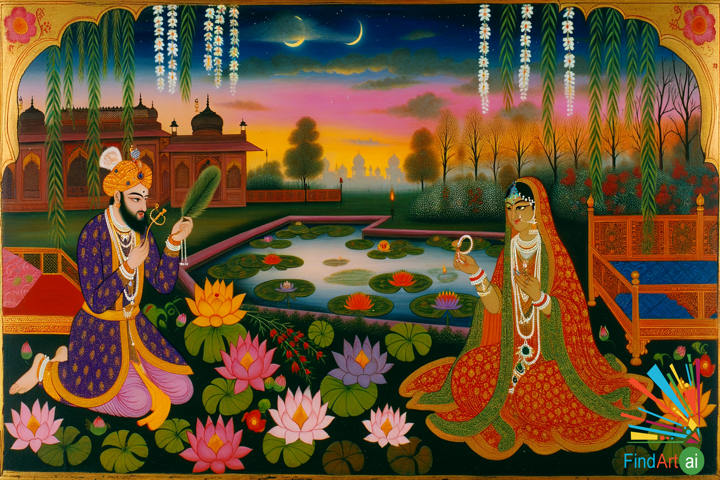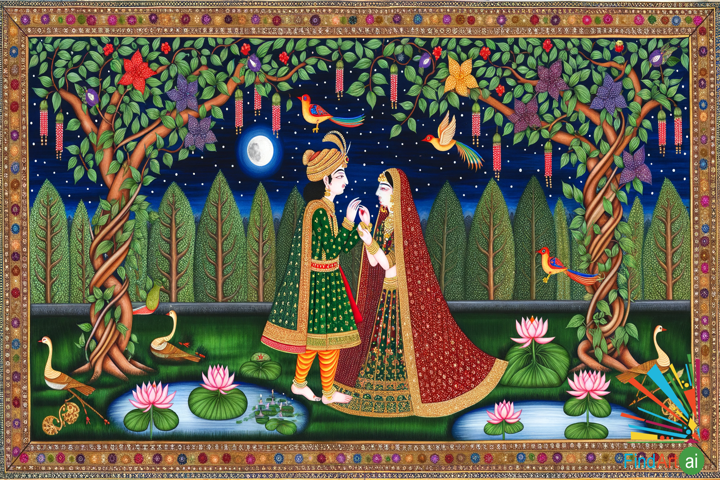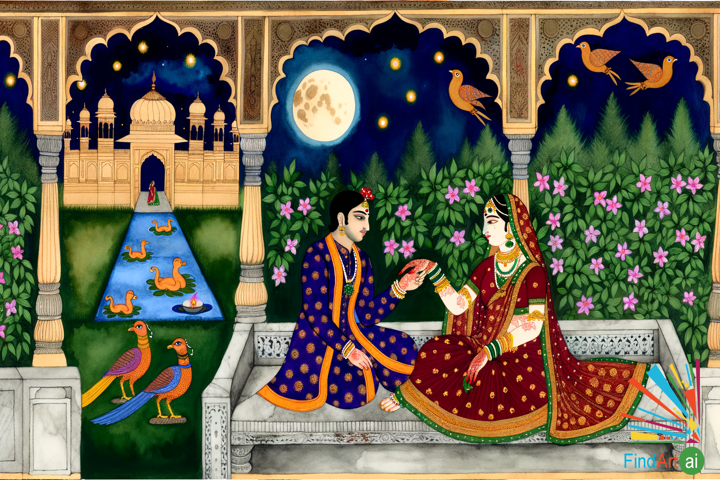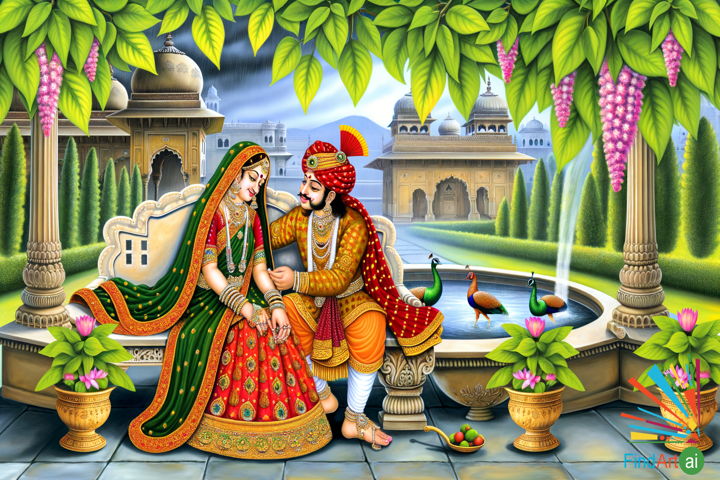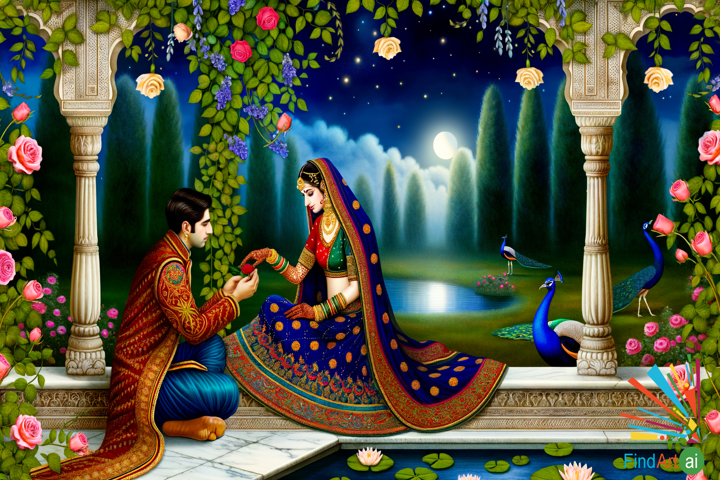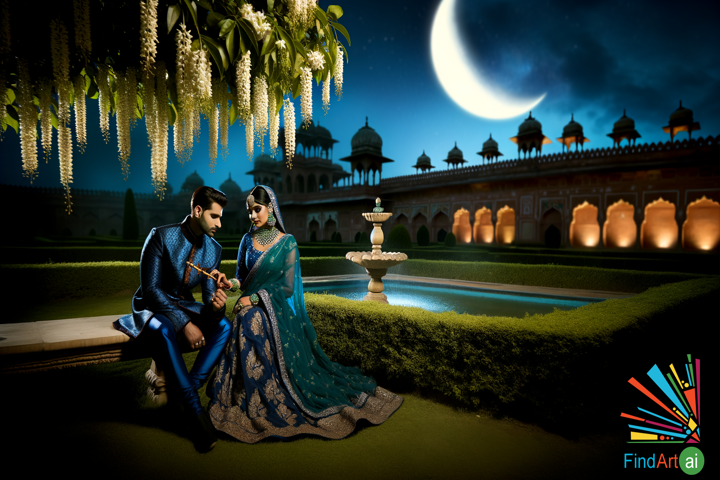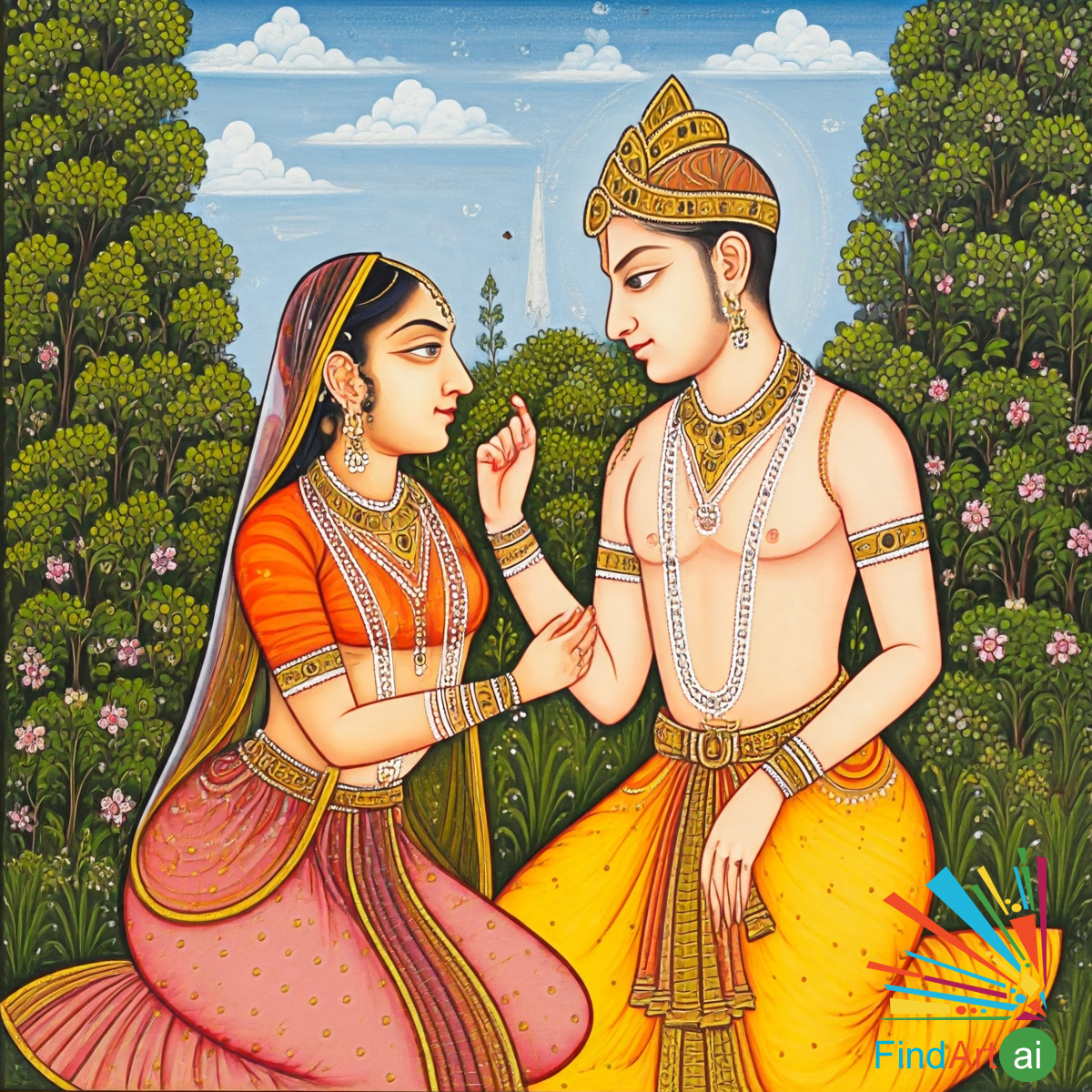
Indian Miniature Paintings with Love and Romance Theme
Indian Miniature Paintings with the Love and Romance theme are known for their intricate details, vibrant colors, and rich symbolism that depict idealized and poetic representations of romantic relationships, often intertwined with nature and mythology. These paintings commonly portray courtly love, divine romances between deities, or passionate human connections, framed within lush natural settings. The theme of love is expressed not just through the figures of lovers, but through the use of symbolic elements such as gardens, flowers, animals, and celestial bodies, emphasizing the harmony between human emotions and the natural world.
Key Characteristics of Indian Miniature Paintings with the Love and Romance Theme
- Romanticized Depictions of Lovers
- The theme of love is often shown through idealized depictions of lovers, portrayed in graceful, intimate poses. The expressions of longing, affection, and passion are central to these compositions, often set against beautifully detailed backgrounds.
- Example: Paintings from the Kangra school depict the romance between the Hindu god Krishna and his beloved Radha, where Krishna serenades Radha with a flute in a lush, moonlit garden, symbolizing divine love.
- Symbolism of Nature and Seasons
- Nature plays a significant role in Indian miniature paintings, especially when conveying romantic themes. The changing seasons, blooming flowers, and lush gardens symbolize the blossoming of love, passion, and longing. Spring and the monsoon seasons are particularly associated with romance, as they represent renewal and growth.
- Example: A couple might be depicted sitting in a garden pavilion surrounded by flowering trees, birds, and rivers, all symbolizing the abundance and beauty of their love.
- Sensual and Elegant Poses
- The lovers in Indian miniature paintings are often shown in graceful and sensuous poses that highlight the emotional and physical connection between them. The use of flowing garments and delicate body language accentuates the intimacy of their relationship.
- Example: A painting from the Rajasthani tradition may show a prince and his consort embracing on a palace balcony, their finely painted jewelry and delicate features enhancing the romantic atmosphere.
- Mythological and Divine Romance
- Indian miniature paintings frequently depict the love stories of gods and goddesses, where divine romances are idealized as metaphors for spiritual devotion. These stories are often drawn from Hindu mythology, particularly the romantic exploits of deities like Krishna and Radha, or Shiva and Parvati.
- Example: In a Pahari miniature, Krishna might be shown lovingly teasing Radha under a tree, while the surrounding nature—flowers, peacocks, and rivers—reflects the intensity of their divine love.
- Vibrant Use of Color
- Indian miniature paintings are renowned for their bright and harmonious use of color, which helps to set the emotional tone. Warm reds, pinks, and golds are often used to symbolize love, passion, and beauty, while cool blues and greens convey the serenity and tenderness of the romantic scenes.
- Example: The lovers may be surrounded by a vibrant red or pink backdrop with golden highlights, representing the warmth and intensity of their emotions, while delicate blues in the sky or water evoke a tranquil, serene setting.
- Attention to Detail and Ornamentation
- Every element in Indian miniature paintings, from the clothing of the figures to the flowers in the background, is meticulously detailed. The lavish clothing, jewelry, and architecture in the paintings are symbolic of courtly luxury and refined romantic ideals.
- Example: A painting might show a royal couple enjoying a romantic moment in a palace garden, with intricate patterns on their garments, detailed carvings on the pavilion, and finely painted floral motifs.
- Private and Intimate Settings
- The romantic encounters in Indian miniature paintings are often set in intimate, secluded spaces such as garden pavilions, moonlit courtyards, or palace chambers. These settings provide a private, serene environment where the lovers can express their affection away from the outside world.
- Example: A painting might depict lovers sitting together on a terrace at night, with the moonlight softly illuminating the scene, enhancing the sense of intimacy and privacy.
- Use of Poetic and Literary Themes
- Many Indian miniature paintings are inspired by classical Indian literature and poetry, especially romantic epics such as the Ramayana, Mahabharata, and Gita Govinda, which explore themes of love, devotion, and longing.
- Example: Scenes from the Gita Govinda, which narrate the love between Krishna and Radha, are commonly depicted, with each painting capturing a moment of deep emotional connection or yearning, often accompanied by verses from the poem inscribed on the borders.
Common Themes in Indian Miniature Paintings with Love and Romance
- Longing and Separation
- The theme of longing, especially during periods of separation, is a recurrent subject. These paintings capture the emotional intensity of lovers who are apart, with the natural surroundings often mirroring their inner feelings.
- Example: A painting might show a forlorn Radha waiting for Krishna under a tree, with the sky darkening and the wind picking up, symbolizing her emotional turmoil in his absence.
- Festivities and Courtship
- Many romantic Indian miniatures are set during festivals or courtship rituals, where the joyous atmosphere and the celebrations serve as a backdrop for the blossoming of love.
- Example: A Holi festival scene might depict a young couple playfully throwing colored powders at each other, symbolizing the vibrant and playful nature of their affection.
- Divine Love as Metaphor for Spiritual Devotion
- The divine love stories between gods and goddesses are often symbolic of the soul’s longing for union with the divine. These stories express a deeper, spiritual dimension of love, where human desire becomes a metaphor for devotion to the divine.
- Example: Krishna and Radha’s love is often portrayed as a spiritual allegory, with their romantic union symbolizing the ultimate reunion of the soul with God.
- Union in Nature
- The depiction of lovers in harmony with nature—surrounded by gardens, rivers, and animals—reinforces the idea that romantic love is a natural and divine force, an expression of the cosmic order.
- Example: A romantic scene may show a couple seated in a lush garden by a lotus-filled pond, with peacocks in the background, all representing fertility, love, and beauty in nature.
Whispered Promises: A Romantic Twilight by the Lotus Pond in Indian Miniature Art
"Whispered Promises: An Evening by the Lotus Pond" is a captivating painting in the Indian Miniature...
Whispers of Eternal Love: Timeless Romance in Indian Miniature Art Captivates the Heart
"Whispers of Eternal Love" captures timeless romance in Indian Miniature Style. A prince, adorned in...
Whispers of Eternal Love: Indian Miniature Painting of Timeless Romance in a Moonlit Garden
"Whispers of Eternal Love" is an Indian Miniature painting that encapsulates timeless romance. Set i...
Whispers of the Monsoon: Love and Renewal in an Enchanting Indian Miniature Painting
"Whispers of the Monsoon" is an enchanting Indian miniature painting that captures love amid the mon...
Eternal Love: A Timeless Romance in a Moonlit Garden of Jasmine and Roses
"Whispers of Eternal Love" portrays a timeless romance in an enchanting twilight garden. Two lovers ...
Whispers of Eternal Love: A Moonlit Romance in a Lush Mughal Garden
"Whispers of Eternal Love" captures a moonlit night in a lush Mughal garden where two lovers sit und...

